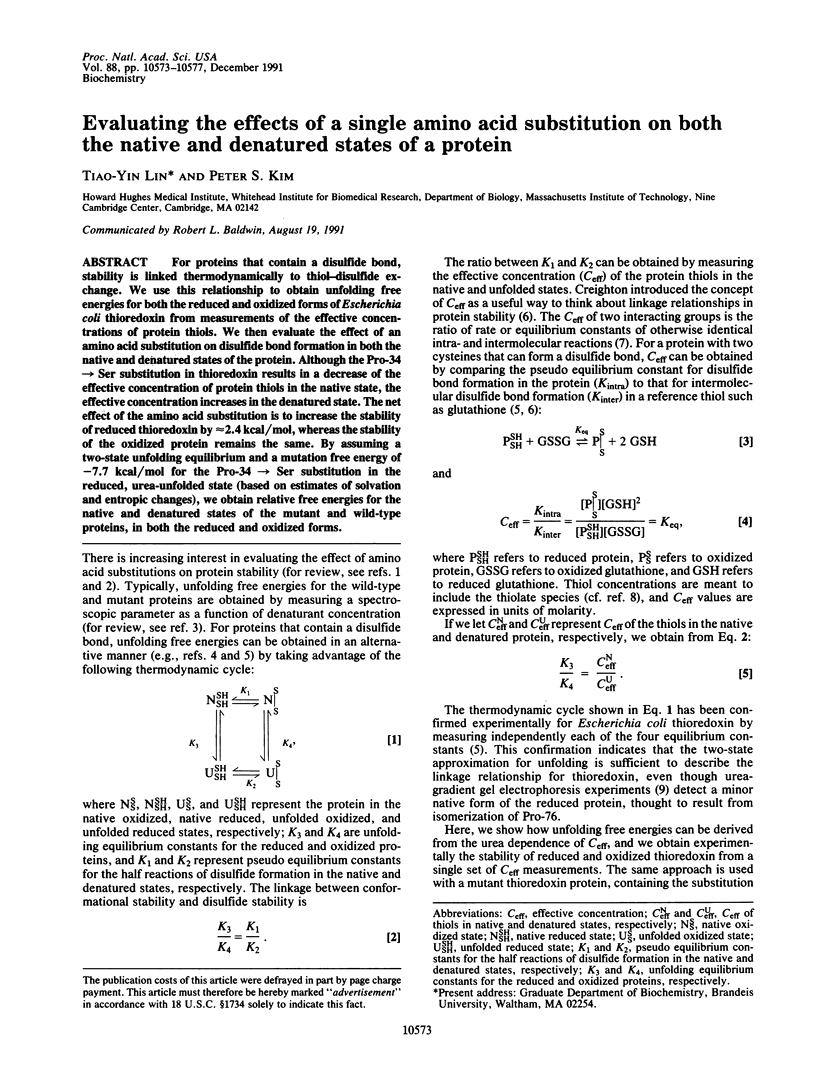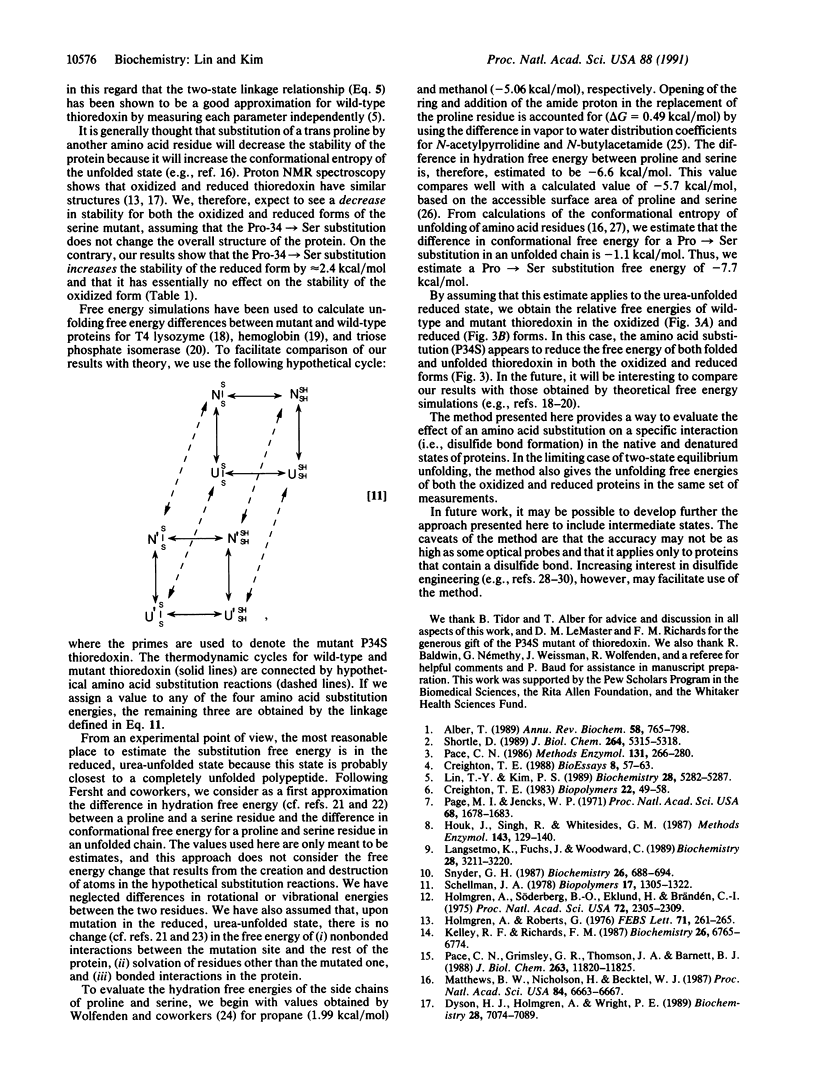Abstract
For proteins that contain a disulfide bond, stability is linked thermodynamically to thiol-disulfide exchange. We use this relationship to obtain unfolding free energies for both the reduced and oxidized forms of Escherichia coli thioredoxin from measurements of the effective concentrations of protein thiols. We then evaluate the effect of an amino acid substitution on disulfide bond formation in both the native and denatured states of the protein. Although the Pro-34----Ser substitution in thioredoxin results in a decrease of the effective concentration of protein thiols in the native state, the effective concentration increases in the denatured state. The net effect of the amino acid substitution is to increase the stability of reduced thioredoxin by approximately 2.4 kcal/mol, whereas the stability of the oxidized protein remains the same. By assuming a two-state unfolding equilibrium and a mutation free energy of -7.7 kcal/mol for the Pro-34----Ser substitution in the reduced, urea-unfolded state (based on estimates of solvation and entropic changes), we obtained relative free energies for the native and denatured states of the mutant and wild-type proteins, in both the reduced and oxidized forms.
Full text
PDF




Selected References
These references are in PubMed. This may not be the complete list of references from this article.
- Alber T. Mutational effects on protein stability. Annu Rev Biochem. 1989;58:765–798. doi: 10.1146/annurev.bi.58.070189.004001. [DOI] [PubMed] [Google Scholar]
- Creighton T. E. An empirical approach to protein conformation stability and flexibility. Biopolymers. 1983 Jan;22(1):49–58. doi: 10.1002/bip.360220110. [DOI] [PubMed] [Google Scholar]
- Creighton T. E. Disulphide bonds and protein stability. Bioessays. 1988 Feb-Mar;8(2):57–63. doi: 10.1002/bies.950080204. [DOI] [PubMed] [Google Scholar]
- Dyson H. J., Holmgren A., Wright P. E. Assignment of the proton NMR spectrum of reduced and oxidized thioredoxin: sequence-specific assignments, secondary structure, and global fold. Biochemistry. 1989 Aug 22;28(17):7074–7087. doi: 10.1021/bi00443a044. [DOI] [PubMed] [Google Scholar]
- Gao J., Kuczera K., Tidor B., Karplus M. Hidden thermodynamics of mutant proteins: a molecular dynamics analysis. Science. 1989 Jun 2;244(4908):1069–1072. doi: 10.1126/science.2727695. [DOI] [PubMed] [Google Scholar]
- Holmgren A., Roberts G. Nuclear magnetic resonance studies of redox-induced conformational changes in thioredoxin from Escherichia coli. FEBS Lett. 1976 Dec 1;71(2):261–265. doi: 10.1016/0014-5793(76)80946-5. [DOI] [PubMed] [Google Scholar]
- Holmgren A., Söderberg B. O., Eklund H., Brändén C. I. Three-dimensional structure of Escherichia coli thioredoxin-S2 to 2.8 A resolution. Proc Natl Acad Sci U S A. 1975 Jun;72(6):2305–2309. doi: 10.1073/pnas.72.6.2305. [DOI] [PMC free article] [PubMed] [Google Scholar]
- Houk J., Singh R., Whitesides G. M. Measurement of thiol-disulfide interchange reactions and thiol pKa values. Methods Enzymol. 1987;143:129–140. doi: 10.1016/0076-6879(87)43023-1. [DOI] [PubMed] [Google Scholar]
- Kelley R. F., Richards F. M. Replacement of proline-76 with alanine eliminates the slowest kinetic phase in thioredoxin folding. Biochemistry. 1987 Oct 20;26(21):6765–6774. doi: 10.1021/bi00395a028. [DOI] [PubMed] [Google Scholar]
- Kellis J. T., Jr, Nyberg K., Sali D., Fersht A. R. Contribution of hydrophobic interactions to protein stability. Nature. 1988 Jun 23;333(6175):784–786. doi: 10.1038/333784a0. [DOI] [PubMed] [Google Scholar]
- Langsetmo K., Fuchs J., Woodward C. Escherichia coli thioredoxin folds into two compact forms of different stability to urea denaturation. Biochemistry. 1989 Apr 18;28(8):3211–3220. doi: 10.1021/bi00434a015. [DOI] [PubMed] [Google Scholar]
- Lin T. Y., Kim P. S. Urea dependence of thiol-disulfide equilibria in thioredoxin: confirmation of the linkage relationship and a sensitive assay for structure. Biochemistry. 1989 Jun 13;28(12):5282–5287. doi: 10.1021/bi00438a054. [DOI] [PubMed] [Google Scholar]
- Matouschek A., Kellis J. T., Jr, Serrano L., Fersht A. R. Mapping the transition state and pathway of protein folding by protein engineering. Nature. 1989 Jul 13;340(6229):122–126. doi: 10.1038/340122a0. [DOI] [PubMed] [Google Scholar]
- Matsumura M., Becktel W. J., Levitt M., Matthews B. W. Stabilization of phage T4 lysozyme by engineered disulfide bonds. Proc Natl Acad Sci U S A. 1989 Sep;86(17):6562–6566. doi: 10.1073/pnas.86.17.6562. [DOI] [PMC free article] [PubMed] [Google Scholar]
- Matthews B. W., Nicholson H., Becktel W. J. Enhanced protein thermostability from site-directed mutations that decrease the entropy of unfolding. Proc Natl Acad Sci U S A. 1987 Oct;84(19):6663–6667. doi: 10.1073/pnas.84.19.6663. [DOI] [PMC free article] [PubMed] [Google Scholar]
- Mitchinson C., Wells J. A. Protein engineering of disulfide bonds in subtilisin BPN'. Biochemistry. 1989 May 30;28(11):4807–4815. doi: 10.1021/bi00437a043. [DOI] [PubMed] [Google Scholar]
- Ooi T., Oobatake M., Némethy G., Scheraga H. A. Accessible surface areas as a measure of the thermodynamic parameters of hydration of peptides. Proc Natl Acad Sci U S A. 1987 May;84(10):3086–3090. doi: 10.1073/pnas.84.10.3086. [DOI] [PMC free article] [PubMed] [Google Scholar]
- Pace C. N. Determination and analysis of urea and guanidine hydrochloride denaturation curves. Methods Enzymol. 1986;131:266–280. doi: 10.1016/0076-6879(86)31045-0. [DOI] [PubMed] [Google Scholar]
- Pace C. N., Grimsley G. R., Thomson J. A., Barnett B. J. Conformational stability and activity of ribonuclease T1 with zero, one, and two intact disulfide bonds. J Biol Chem. 1988 Aug 25;263(24):11820–11825. [PubMed] [Google Scholar]
- Page M. I., Jencks W. P. Entropic contributions to rate accelerations in enzymic and intramolecular reactions and the chelate effect. Proc Natl Acad Sci U S A. 1971 Aug;68(8):1678–1683. doi: 10.1073/pnas.68.8.1678. [DOI] [PMC free article] [PubMed] [Google Scholar]
- Shortle D. Probing the determinants of protein folding and stability with amino acid substitutions. J Biol Chem. 1989 Apr 5;264(10):5315–5318. [PubMed] [Google Scholar]
- Snyder G. H. Intramolecular disulfide loop formation in a peptide containing two cysteines. Biochemistry. 1987 Feb 10;26(3):688–694. doi: 10.1021/bi00377a005. [DOI] [PubMed] [Google Scholar]
- Tidor B., Karplus M. Simulation analysis of the stability mutant R96H of T4 lysozyme. Biochemistry. 1991 Apr 2;30(13):3217–3228. doi: 10.1021/bi00227a009. [DOI] [PubMed] [Google Scholar]
- Wetzel R., Perry L. J., Baase W. A., Becktel W. J. Disulfide bonds and thermal stability in T4 lysozyme. Proc Natl Acad Sci U S A. 1988 Jan;85(2):401–405. doi: 10.1073/pnas.85.2.401. [DOI] [PMC free article] [PubMed] [Google Scholar]
- Wolfenden R., Andersson L., Cullis P. M., Southgate C. C. Affinities of amino acid side chains for solvent water. Biochemistry. 1981 Feb 17;20(4):849–855. doi: 10.1021/bi00507a030. [DOI] [PubMed] [Google Scholar]


